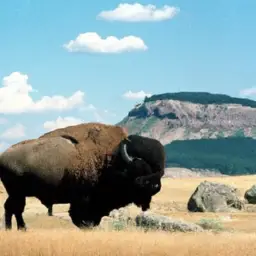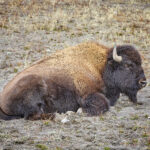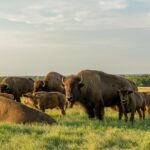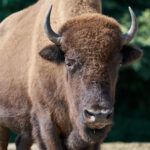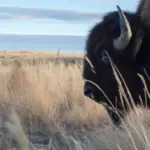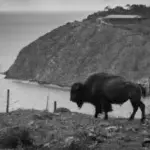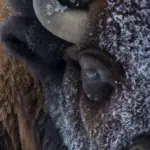If you’ve ever wondered about the organization responsible for reintroducing bison to the Western US, then look no further. This article will shed light on the efforts of the group behind this conservation project, sharing the story of how they played a significant role in bringing back this iconic species to its native habitat. Discover the challenges they faced, the strategies they employed, and the positive impact their actions have had on the Western landscape and the bison population. Get ready to learn about the inspiring work of the organization behind the successful reintroduction of bison to the Western US!
Historical Overview of Bison in The Western U.S.
Origins of bison in America
The American bison, also known as the buffalo, has a rich history in the Western United States. They have been a part of the continent for thousands of years, with evidence suggesting their presence since the Ice Age. It is believed that bison crossed the Bering land bridge from Asia to North America, establishing their population across the Great Plains and Rocky Mountains.
Role of bison in indigenous cultures
Bison played a crucial role in the lives and cultures of indigenous peoples in the Western United States. Tribes such as the Lakota, Cheyenne, and Blackfeet relied heavily on bison for sustenance, utilizing every part of the animal for food, shelter, clothing, and tools. The bison provided not only physical resources but also held immense cultural and spiritual significance, serving as a symbol of strength, abundance, and unity for these communities.
The decline of the bison population during the 19th century
Unfortunately, the 19th century marked a devastating decline in the bison population. Various factors, such as westward expansion, unregulated hunting, and the impact of the railroad, led to their near extinction. The introduction of firearms made it easier for hunters to target and kill large numbers of bison, primarily for their valuable hides. This rapid decimation of the bison population had severe consequences for both the species and the ecosystems they inhabited.
Bison Extinction Crisis
Threats leading to near extinction
The relentless hunting of bison during the 19th century posed a significant threat to their survival. Commercial hunting for their hides and the desire to eliminate the bison as a means to control Indigenous populations pushed the bison population to the brink of extinction. By the 1880s, it is estimated that there were less than 1,000 bison remaining in North America.
Impact of the bison loss on ecosystems
The near extinction of bison had cascading effects on the ecosystems of the Western United States. Bison were a keystone species, meaning that their presence and behaviors influenced the health and functioning of entire ecosystems. Their grazing patterns helped to shape the landscape, promote plant diversity, and provide habitat for countless other species. Without the bison, these ecosystems suffered, resulting in imbalances and a loss of biodiversity.
Legal protections placed for bison
Recognizing the dire situation faced by bison, legal protections were put in place to safeguard their remaining population. The Lacey Act of 1894 prohibited the transportation of illegally obtained wildlife across state lines, providing some level of protection for bison. Additionally, various national parks and reserves were established to preserve and restore bison populations, ensuring their survival and recovery.
The Role of Organizations in Bison Conservation
The importance of species reintroduction
Species reintroduction programs play a critical role in conservation efforts, aiming to restore the population of a species in its native habitat. Bison reintroduction is vital not only for the survival of the species but also for the restoration and preservation of ecosystems that depend on their presence.
Organizations involved in wildlife conservation
Several organizations have played significant roles in the conservation efforts for bison, working tirelessly to reintroduce and protect the species. The American Bison Society (ABS), the Wildlife Conservation Society (WCS), and the National Park Service are among the prominent organizations that have dedicated themselves to bison conservation.
Specific need for bison reintroduction
Bison reintroduction is crucial to reverse the detrimental effects of their near extinction. It not only helps to restore their populations but also contributes to the revitalization of ecosystems, restoring ecological balance, and promoting biodiversity. Reintroducing bison ensures the preservation of cultural heritage and provides economic benefits, making it an essential undertaking for organizations like ABS.
Introduction to The American Bison Society (ABS)
Establishment and role of ABS
The American Bison Society (ABS) was founded in 1905, with the primary goal of saving the American bison from extinction. It was established by a group of influential conservationists, scientists, and concerned individuals who recognized the urgent need for action to protect this iconic species. ABS quickly gained recognition and support, becoming a pivotal organization in bison conservation efforts.
Early conservation efforts by ABS
In its early years, ABS focused on breeding bison and establishing protected herds in national parks and wildlife reserves. It aimed to increase the overall population of bison, primarily through captive breeding programs. These efforts were instrumental in preventing the complete extinction of the species, laying the foundation for future reintroduction initiatives.
ABS partnerships for bison conservation
ABS forged partnerships with various organizations, government agencies, and indigenous communities to further its mission of bison conservation. Collaborating with the National Park Service, the Wildlife Conservation Society, and other entities allowed ABS to pool resources, expertise, and support for widespread conservation efforts. This collaborative approach has been essential in the successful reintroduction and preservation of bison populations.
ABS’s Role in Reintroducing Bison to The Western U.S.
ABS’s strategy for bison reintroduction
ABS has implemented a strategic approach to bison reintroduction, focusing on carefully selecting suitable release sites and closely monitoring population dynamics. Through scientific research and ecological assessments, ABS identifies areas where bison can thrive, taking into consideration factors such as habitat suitability, availability of resources, and potential impacts on local communities and ecosystems.
Key reintroduction initiatives by ABS
ABS has led several successful bison reintroduction initiatives in the Western United States. Projects such as the reintroduction of bison in Yellowstone National Park and the Elk Island National Park in Canada have been instrumental in expanding bison populations and restoring their ecological roles. These efforts have served as models for subsequent reintroduction projects.
ABS’s success in bison population recovery
Thanks to ABS’s relentless efforts, the American bison population has shown significant signs of recovery. From the brink of extinction, the population has rebounded to over 500,000 individuals today. ABS’s conservation strategies, in collaboration with other organizations, have played a vital role in restoring the bison population and ensuring its long-term survival.
Collaboration with Other Organizations
Relationship between ABS and national parks
ABS has maintained a strong partnership with the National Park Service, working hand in hand to reintroduce bison to various national parks across the Western United States. National parks provide protected habitats where bison populations can grow and thrive. ABS has provided the expertise and resources necessary to ensure the successful reintroduction and management of bison within these parks.
Support from other wildlife conservation organizations
ABS has received widespread support from other wildlife conservation organizations, such as the Wildlife Conservation Society. Collective efforts have been crucial in raising awareness, securing funding, and implementing effective conservation strategies. The collaboration between these organizations has strengthened the reintroduction efforts and facilitated the long-term viability of bison populations.
Role of local communities and indigenous tribes
Local communities and indigenous tribes have played a significant role in the reintroduction efforts facilitated by ABS. Their traditional knowledge, cooperation, and engagement have been critical to the successful establishment and management of bison herds. These communities recognize the cultural, ecological, and economic significance of bison, ensuring their active participation in conservation initiatives.
Notable Reintroduction Successes
ABS release of bison in specific Western U.S. locations
ABS has successfully reintroduced bison in various locations across the Western United States. Notably, the release of bison in Yellowstone National Park has been a remarkable achievement, where the population has thrived and become an iconic symbol of conservation success. Additionally, bison reintroduction projects in Theodore Roosevelt National Park and Wind Cave National Park have seen population growth and ecological restoration.
Population regrowth stats
The reintroduction efforts led by ABS have had a profound impact on bison population growth. From the mere hundreds that remained in the 19th century, the population has now reached over 500,000 individuals. This remarkable recovery is a testament to the effectiveness of conservation strategies and the dedication of organizations like ABS.
Success stories of recovered ecosystems due to bison reintroduction
Alongside the resurgence of the bison population, ecosystems have also experienced significant recovery. The grazing behaviors of bison have reshaped landscapes, leading to increased plant diversity and providing habitat for numerous other species. Restoring the ecological balance has resulted in healthier and more resilient ecosystems, promoting the overall well-being of the Western U.S.
Challenges Faced During Reintroduction
Issues in breeding and transporting bison
Breeding and transporting bison present unique challenges during reintroduction efforts. Bison are large and powerful animals, requiring specialized facilities and expert knowledge to ensure successful breeding programs. Furthermore, safely transporting bison to release sites can be logistically complex, requiring careful planning, transportation infrastructure, and minimizing stress on the animals.
Resistance or conflicts with local communities
Despite the benefits of bison reintroduction, conflicts sometimes arise between conservation organizations and local communities. Concerns over land use, potential impacts on agriculture, and fears of the animals straying beyond park boundaries can create tensions. Open dialogue, community involvement, and collaboration are crucial to addressing these concerns and finding mutually beneficial solutions.
Difficulties in managing growing bison populations
As bison populations recover and thrive, managing their growth and impact becomes a significant challenge. Balancing ecological restoration, the needs of local communities, and sustainable population numbers requires adaptive management strategies. Collaborative efforts between organizations, communities, and government agencies are essential to ensure the long-term success of bison reintroduction programs.
Continuing Efforts and Future Plans
Current status of bison population in the Western U.S.
The current status of the bison population in the Western United States is encouraging, with over 500,000 individuals contributing to healthy ecosystems and cultural preservation. Ongoing monitoring, research, and management efforts are necessary to maintain sustainable population growth and prevent any potential setbacks to their recovery.
ABS’s ongoing projects for bison conservation
ABS continues to spearhead numerous projects aimed at bison conservation and reintroduction. Efforts include habitat restoration, scientific research on bison behavior and ecology, and the implementation of breeding and genetic diversity programs. These ongoing projects are essential for ensuring the long-term survival and well-being of bison populations.
Future strategies for preservation and growth of bison herds
Looking ahead, organizations like ABS will continue to focus on preserving and expanding bison herds in the Western United States. Prioritizing habitat restoration, ensuring genetic diversity, and promoting community engagement will be critical for the long-term growth and resilience of bison populations. By adapting conservation strategies based on scientific knowledge, ABS is striving to secure a prosperous future for this iconic species.
How Did the Reintroduction of Bison to the Western US Impact the Valuable Parts of the Bison for White Settlers?
The reintroduction of bison brought a resurgence of part of the bison valuable to white settlers, including hides and bone. These resources spurred economic growth, with hides for leather goods and bones for fertilizer and tools, intertwining the fate of the Plains’ ecology with commerce once more.
Benefits of Bison Reintroduction to Ecosystem and Society
Contribution of bison to biodiversity
Bison play a vital role in enhancing biodiversity within their ecosystems. Their grazing habits create diverse habitats by promoting the growth of various plant species and maintaining open landscapes. This, in turn, supports the survival of numerous other animal and plant species, contributing to the overall health and richness of the ecosystem.
Cultural significance and importance to indigenous communities
The bison holds immense cultural significance for indigenous communities in the Western United States. Reintroducing bison not only preserves cultural heritage but also strengthens the connection between indigenous peoples and their ancestral lands. The presence of bison offers opportunities for cultural revitalization, traditional practices, and economic benefits for these communities.
Economic advantages and potential from bison reintroduction
Bison reintroduction brings economic advantages to both local communities and the broader society. Bison-related tourism, such as guided tours, photography, and educational programs, generates revenue and employment opportunities. Additionally, the production and sale of bison meat and by-products contribute to local economies and promote sustainable food sources. The economic potential of bison reintroduction provides further incentives for conservation efforts.
In conclusion, the historical overview of bison in the Western United States highlights the significance of bison in indigenous cultures, the drastic decline they faced in the 19th century, and the subsequent bison extinction crisis. Organizations like the American Bison Society (ABS) play a vital role in bison conservation, leading reintroduction efforts, collaborating with other organizations, and forming partnerships with national parks and indigenous communities. With notable successes in reintroduction, ABS has contributed to the recovery of the bison population and the restoration of ecosystems throughout the Western U.S. Challenges such as breeding and transportation, conflicts with local communities, and managing growing populations must be overcome to ensure the continued success of bison conservation. The ongoing efforts of ABS and other organizations will focus on preserving and growing bison herds, benefiting ecosystems, cultural preservation, and promoting economic advantages for society. By recognizing the importance of bison reintroduction, we can ensure a brighter future for these iconic creatures and the Western United States as a whole.

